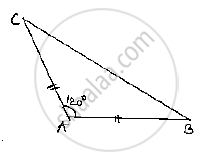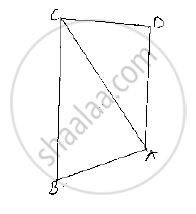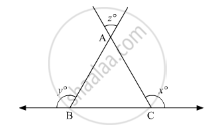Advertisements
Advertisements
प्रश्न
In a ΔABC, if ∠A=l20° and AB = AC. Find ∠B and ∠C.
उत्तर
Consider a ΔABC,
Given that ∠A = 120° and AB = AC and given to find ∠B and ∠C
We can observe that DABC is an isosceles triangle since AB = AC
⇒∠B=∠C ………(1) [Angles opposite to equal sides are equal]
We know that sum of angles in a triangle is equal to `180^@`
`⇒∠A+∠B+∠C=180^@`
⇒`∠A+∠B+∠B=180^@` [from (1)]
⇒`120^@+2∠B=180^@`
⇒`2∠B=180^@-120^@`
⇒`2∠B=60^@⇒∠B=30^@`
⇒`∠C=∠B=30^@`

APPEARS IN
संबंधित प्रश्न
If the bisector of the exterior vertical angle of a triangle be parallel to the base. Show that the triangle is isosceles.
Which of the following statements are true (T) and which are false (F):
Angles opposite to equal sides of a triangle are equal
In ΔABC, if ∠A = 40° and ∠B = 60°. Determine the longest and shortest sides of the triangle.
Is it possible to draw a triangle with sides of length 2 cm, 3 cm and 7 cm?
In Fig. 10.131, prove that: (i) CD + DA + AB + BC > 2AC (ii) CD + DA + AB > BC

Which of the following statements are true (T) and which are false (F)?
Difference of any two sides of a triangle is equal to the third side.
In the given figure, what is z in terms of x and y?

In ∆ABC, BC = AB and ∠B = 80°. Then ∠A is equal to ______.
In ∆PQR, if ∠R > ∠Q, then ______.
Is it possible to construct a triangle with lengths of its sides as 9 cm, 7 cm and 17 cm? Give reason for your answer.
